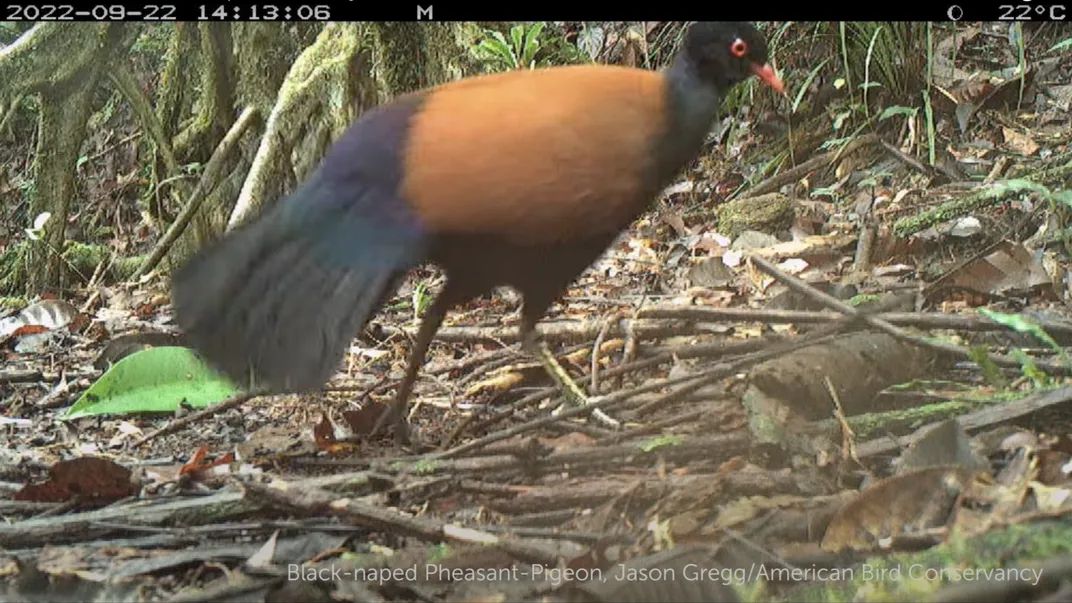These ‘Lost’ Bird Species Haven’t Been Seen in at Least a Decade—and Scientists Want Help Finding Them
Some of the 126 species on their list haven’t been photographed or recorded in more than century
:focal(800x450:801x451)/https://tf-cmsv2-smithsonianmag-media.s3.amazonaws.com/filer_public/15/7a/157a04b2-c7e7-44ab-8948-73498602bac3/black-naped-pheasant-pigeon-by-doka-nason_american-bird-conservancy_1600x900.png)
Nearly 12,000 species of birds exist in the wild, and every day, humans document their sightings of the animals. But a handful of avian species haven’t been spotted in years—or, in some cases, in more than a century.
Now, scientists have compiled an up-to-date list of “lost” birds—and they’re asking members of the public to keep an eye out for these elusive winged creatures.
Humans have driven an estimated 1,430 bird species extinct over the last 130,000 years. But the birds on the new list are not necessarily gone—they just haven’t been photographed or recorded in at least a decade.
To come up with the list, researchers analyzed more than 42 million photos, sound recordings and videos captured by amateur birders and uploaded to the citizen science platforms of iNaturalist, Xeno-Canto and the Macaulay Library, which includes eBird. They also looked at scientific papers, museum collections and media from search engines, and they consulted with local experts.
In a June paper published in Frontiers in Ecology and the Environment, the team described 144 bird species that had not been documented in more than a decade. But they conducted that analysis two years ago, and since then, recent sightings and a few classification technicalities have brought that number down to 126 lost birds, according to a statement from the American Bird Conservancy.
SPECIES REDISCOVERED! An expedition led by our Madagascar Program team rediscovered the dusky tetraka, a songbird that hasn't been seen in 24 years. Read the story here: https://t.co/PWW0sMNZdG
— The Peregrine Fund (@peregrinefund) March 1, 2023
The Peregrine Fund's Dr. Rene de Roland with dusky tetraka by John C. Mittermeir pic.twitter.com/tZ9xqj4OX5
The 126 lost birds represent roughly 1 percent of the total known 11,849 bird species. But several endangered or critically endangered species are included on the list, and finding them is “essential” for preventing their extinction, says study co-author Cameron Rutt, an ornithologist at Louisiana State University and the former lost birds science coordinator for the American Bird Conservancy, in the statement.
“Through more exposure in global ornithological and birding networks, there’s great potential to learn more about birds that are poorly known and highly threatened,” Rutt tells the New York Times’ Jim Robbins.
The lost birds live all over the world, and they range from tiny hummingbirds to rotund ducks. They’re considered lost for a variety of reasons—some live in remote, hard-to-reach places, while others are dwindling because of climate change, habitat loss and other human-driven causes.
“One of the things I learned from doing this is how many whimbrel and curlew relatives have likely gone extinct or seem to be heading in that direction,” says study co-author Eliot Miller, an ornithologist with the American Bird Conservancy, in a Cornell University statement. “It seems to be a group of birds that does not do well with people.”
Some species haven’t been seen in more than 150 years, including the coppery thorntail, the New Caledonian lorikeet and the Jamaican pauraque. Others, meanwhile, became lost more recently, like the Papuan whipbird, which was last documented 13 years ago.
In North America, the list includes species such as the ivory-billed woodpecker, which hasn’t officially been seen since 1956 (though there have been a few contested sightings since then). Six native species from Hawaii made the list as well.
Some birds that were previously identified as lost have been found in recent years. For example, the Santa Marta sabrewing—a large hummingbird with iridescent green and blue feathers—was rediscovered in Colombia in 2022. Since then, researchers have found roughly 50 of the critically endangered birds, and they’ve been studying the species’ feeding, singing and courtship behaviors.
Also in 2022, the black-naped pheasant-pigeon, also known as the auwo, was rediscovered in Papua New Guinea after having been lost to science for 140 years.
“It feels like finding a unicorn or a Bigfoot,” John C. Mittermeier, an ornithologist who leads the American Bird Conservancy’s Search for Lost Birds program and was a member of the expedition team that documented the black-naped pheasant pigeon, told Audubon magazine’s Andy McGlashen in 2022. “It’s extraordinarily unusual.”
Citizen scientists and local Indigenous communities will likely play a role in finding the lost birds. Though some may be “impossible to find,” others might “reveal themselves relatively quickly if people get to the right places,” Mittermeier, the senior author of the recent paper, says in the American Bird Conservancy statement. From there, scientists can begin to implement conservation efforts to help ensure the species aren’t lost again in the future.
“Figuring out why these birds have become lost and then trying to find them can feel like a detective story,” he adds.
An estimated 2,200 species of plants, animals and fungi—from a rodent called the Ilin Island cloudrunner to the Namdapha flying squirrel—haven’t been seen in at least ten years, according to the nonprofit conservation group Re:wild.
/https://tf-cmsv2-smithsonianmag-media.s3.amazonaws.com/accounts/headshot/SarahKuta.png)



/https://tf-cmsv2-smithsonianmag-media.s3.amazonaws.com/accounts/headshot/SarahKuta.png)